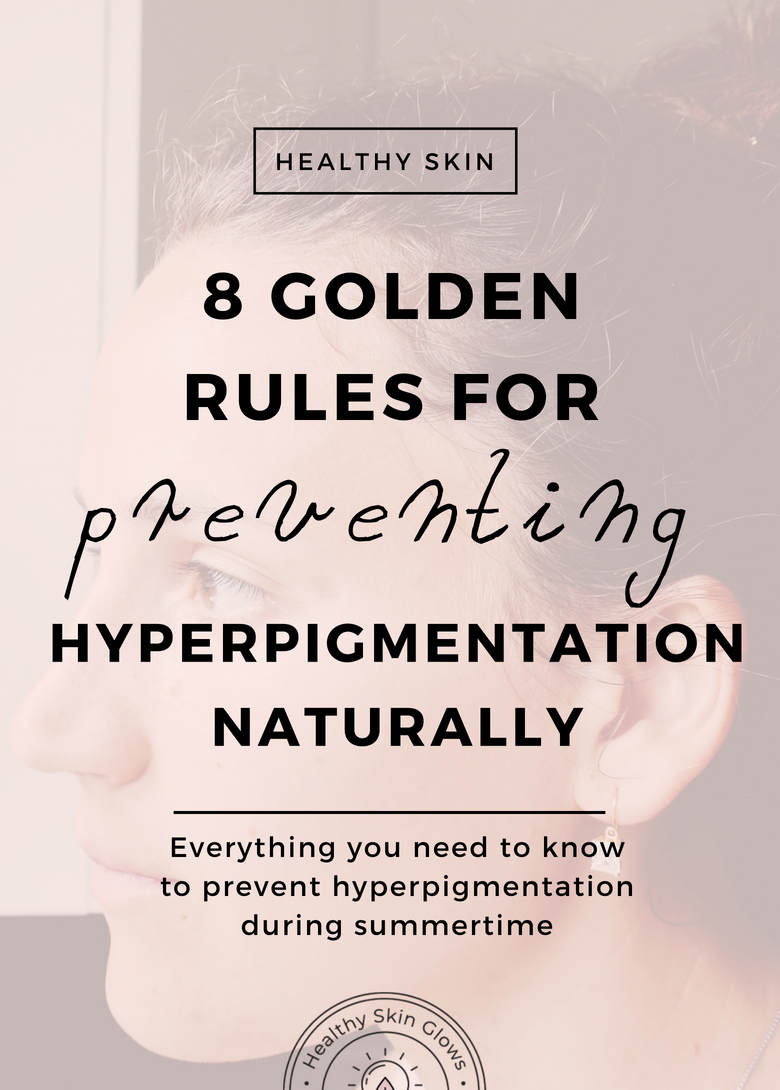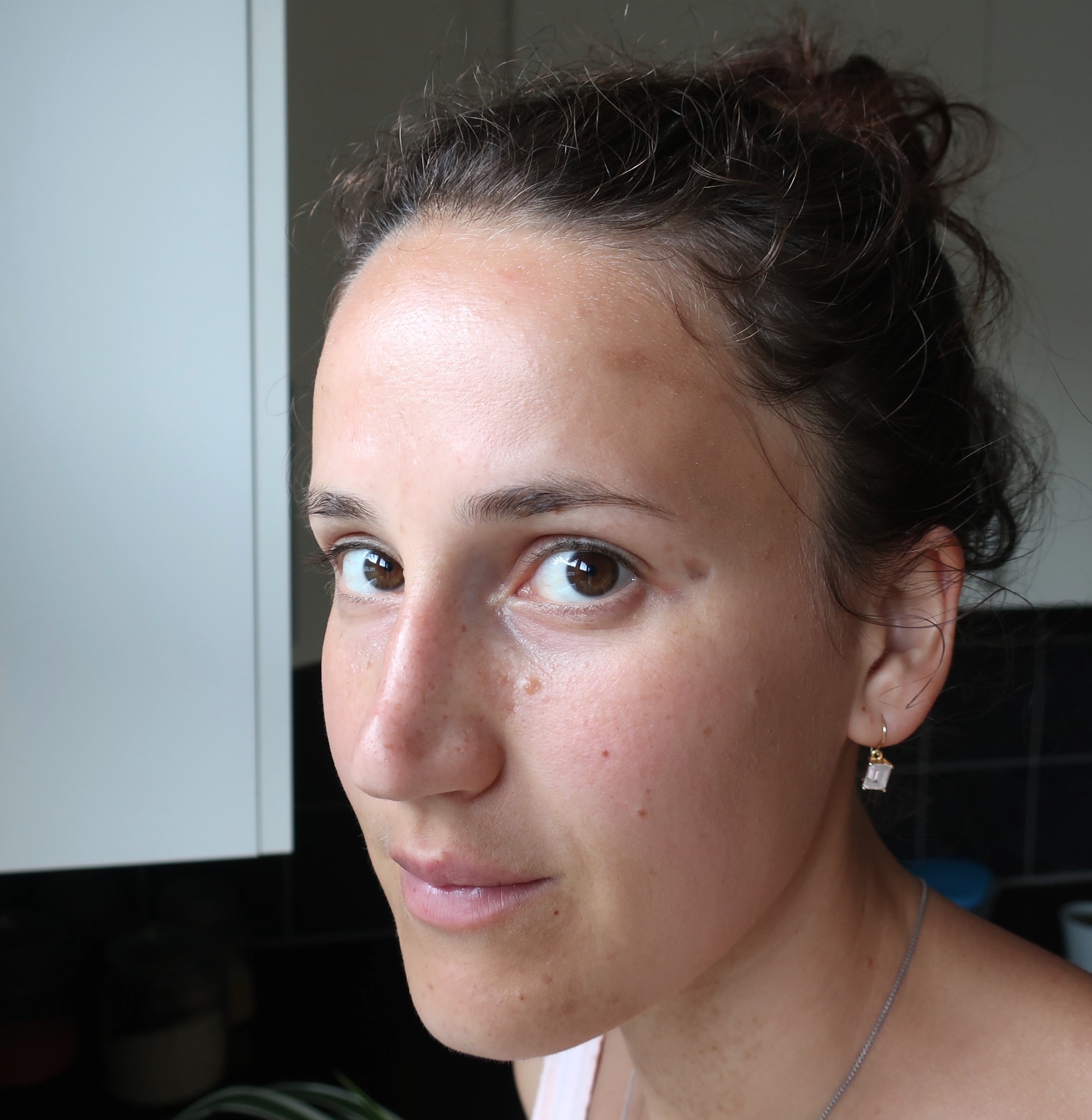
A little while ago, I met one of my best friends for coffee. Right when I saw her, I noticed a hyperpigmentation patch on her forehead.
Before I could even ask: “Have you recently had any peels or other treatments done?”, she said: “I had a chemical peel, and this is what happened!”
You might think that she didn't wear sunscreen afterwards. She did!
The truth is, sunscreen alone cannot always protect your skin enough to prevent hyperpigmentation. Take it from someone who has spent more than half of her life in one of the sunniest places in Europe!
Today I am sharing with you all of my tips to ensure your skin stays spotless, especially during the sunny summer months.
WHAT EXACTLY IS HYPERPIGMENTATION?
Hyperpigmentation happens due to an overproduction of pigment melanin in the skin. Melanin gives your skin color (tan), and its function is to protect your skin from damaging UV rays.
There are three types of hyperpigmentation:
- Sunspots/sun damage — These are very common, and they develop on parts of the skin that are exposed to the sun the most, such as face, chest, neck, and hands. Freckles are also sunspots.
- Melasma — This is a skin discoloration that turns patches of skin light-to-medium brown. Melasma is caused by changes in hormones and tends to occur during pregnancy, when taking birth control pills, or during times of hormonal imbalance. It increases (darkens) with sun exposure.
- Post-Inflammatory Hyperpigmentation (PIH) — You are perhaps most likely to have experienced PIH if you struggle with acne because the scars they leave behind are actually PIH. This kind of discoloration is due to inflammation caused by damage or trauma to the skin, including acne, cuts, burns, insect bites, overuse of certain ingredients (e.g. benzoyl peroxide, retinoids and chemical exfoliants), and cosmetic procedures (lasers, IPL, microdermabrasion, chemical peels).
Cosmetic treatments likely don't lead to hyperpigmentation on their own (as do acne or other wounds), but can cause inflammation and irritation, making your skin more sensitive to the UV rays (even on cloudy days!), which can then trigger hyperpigmentation.
Actually, the exfoliating treatments mentioned above can reduce existing hyperpigmentation, but also cause new one if you are not careful with the sun exposure!
So why would “trauma” or irritation to the skin cause those annoying hyperpigmentation marks?
The answer is inflammation – whether it is visible to you or not.
HYPERPIGMENTATION IS TRIGGERED BY AN INFLAMMATORY EVENT
All types of hyperpigmentation are caused or worsened by inflammation. The most common cause of hyperpigmentation (sun spots) is also a post-inflammatory response to UV damage to the skin. Even when there is no visible redness (erythema), such skin has elevated inflammatory cell content, resulting in an inflammatory process.
Inflammation can result in hyperpigmentation through several mechanisms:
- Direct stimulation of melanocytes (melanin-producing cells) by inflammatory cytokines such as IL-1-α (this one is also involved in acne formation!)
- Reactive oxygen species, such as superoxide and nitric oxide, generated in the damaged skin (for example, from UV exposure) or released from inflammatory cells can also stimulate melanocytes to produce excess melanin
- Damage to epidermal cells (acne, scratches, and cuts) can cause a release of endocrine inducers of pigmentation, such as the α-melanocyte-stimulating hormone. When melanocytes are stimulated, they will produce extra melanin.
So why does your skin tries to produce all this excess melanin after inflammatory incidents?
It's because melanin provides protection against UV-induced damage by scattering UV rays and acting as an antioxidant. Your skin is just trying to protect itself from subsequent insults!
Therefore, we need to eliminate all sources of irritation and inflammation to prevent hyperpigmentation. Especially in the summertime, when the sun is unforgiving!
8 GOLDEN RULES FOR PREVENTING HYPERPIGMENTATION
1. No exfoliation in the morning
Exfoliating removes a layer of dead skin cells from the surface of your skin, leaving your skin instantly brighter. Sounds harmless, right?
Not when done in the morning!
Dead skin cells, together with a lipid matrix that surrounds them, make up the skin barrier. Skin barrier acts like a brick wall – the cells are the ‘bricks' and lipids are the ‘mortar' that holds these cells together. This amazing structure protects the living skin cells underneath, locks the moisture into your skin, and more.
Without a robust skin barrier, your skin is more exposed to the harsh environment, pollution, toxins, pathogens, oxidative damage, and inflammation.
Anything that either removes the top layer of dead skin cells (exfoliants) or helps replace older skin with fresh, new cells, will make your skin more sensitive to the sun, oxidative damage and hyperpigmentation (source).
So, no acids, no retinols, no scrubs, no enzyme masks, and other exfoliating products in the morning.
Related: 5 Reasons Why I Don't Wash My Face In The Morning
Don't get me wrong, gentle exfoliation is amazing for the skin, but leave those treatments for evenings only. Also, if you know you will be a lot in the sun the following day, it might be wise to skip on exfoliation altogether (especially if you are prone to hyperpigmentation).
2. No aggressive professional treatments (peels, lasers, Dermapen, etc) at all
Professional treatments, including chemical peels and dermapen, can be awesome, but they also make your skin more sensitive to the sun, and not just on the day you do it. Even if you were to apply enough sunscreen, and frequently enough (every 2 hours), your skin still might not be as protected as it should be.
Simply reserve these treatments for months with less sun, especially if you are prone to hyperpigmentation!
3. Avoid artificial fragrances (perfumes)
Certain chemicals can trigger melanocytes to produce excess melanin, and the artificial fragrance is a big one! Sadly, it is not found just in perfumes, but also moisturizers, serums and toners. Check all your skincare for fragrances and find safe alternatives.
4. No citrus juices or oils in sunlight
This one is huge!
Certain substances found in citrus oils and juices are photo-toxic, causing damage to the skin when exposed to the sun.
Trust me, it will cause hyperpigmentation mark in no time. This is what happened to me after I touched my skin with some residue of lime juice on my fingers and then spent some time in the sun (I used no other skincare at the time, just my sunscreen). Oh, and excuse my messy hair (#momlife)!

This is actually the first such hyperpigmentation mark for me, and it happened just after writing this article! To avoid my mistake, always wash your hands after handling any kind of citrus, and avoid touching your face.
Photo-toxic skin damage, or even burns, can show up anywhere from 1-24 hours after UV exposure (including tanning beds). Sadly, the resulting discoloration can last for months.
One of the substances causing such reaction in citrus oils is bergaptene. Fresh lemon or lime juice are photo-toxic due to the substances such as furocoumarins, plus some other potentially irritating substances, such as limonene and citral.
Vitamin C serums and various oil-based serums sometimes contain citrus essential oils. When there is a small amount of them, it can be totally fine to use the product. However, it doesn't hurt being careful.
Potentially phototoxic citrus oils include:
- Angelica
- Bergamot
- Grapefruit
- Lemon
- Lemon verbena
- Lime
- Orange
- Wild Orange
- Mandarin Leaf
- Tangerine
Check all your skincare products for these ingredients, and avoid applying them in the morning or before sun exposure unless you are certain that the product formulation is safe for sun exposure.
5. Use antioxidants to reduce oxidative damage and inflammation
Combination of topical antioxidants together with a sunscreen showed a better protection against the sun radiation (source).
The same authors published an article suggesting that another antioxidant mixture (ferulic acid, vitamin E, and vitamin C) was also very effective in enhancing sun protection (source).
Why are antioxidants helpful? Because UV radiation leads to oxidative damage and inflammation, and the role of antioxidants is to stop oxidative damage from happening.
Oxidative damage (can be reduced by antioxidants) -> inflammation -> hyperpigmentation!
Layer your antioxidant-rich serum under a sunscreen every day for best protection.
6. Use only gentle skincare that respects the skin’s pH and skin barrier integrity
Skin's optimal pH (4.5-5.5) is absolutely essential for protecting the skin against negative external influences.
It helps your skin ward off infections, stay optimally moisturized, and it even helps the skin's natural exfoliation process, desquamation. This not only keeps your skin healthy and smooth naturally, but it also minimizes the chances of hyperpigmentation!
7. Load up on omega-3s for extra photoprotection
Omega-3s are one of those miracle substances that provide an added layer of photoprotection – from the inside!
The three main types of omega-3 fatty acids are α-Linolenic acid (ALA), eicosapentaenoic acid (EPA), and docosahexaenoic acid (DHA).
EPA can reduce the collagen damage associated with photoaging, slowing down skin aging.
Omega-3s may also be able to speed up wound healing (a.k.a. after picking your skin and healing the acne scars, which often leave hyperpigmentation marks – PIH).
Eating fatty, sustainably caught fish, like sardines, can help keep your skin moisturized and hyperpigmentation-free.
8. Wear a hat and a well-formulated non-toxic mineral sunscreen
This is the part where I tell you that the type of sunscreen you use is of crucial importance for preventing hyperpigmentation and sun damage!
It is essential that you use a “broad-spectrum” sunscreen. However, not all such sunscreens are equally good. Far from!
Related: Why (Most) Sunscreens Aren't Protecting Your Skin From Sun Damage
For true broad-spectrum protection, I rely only on zinc oxide sunscreens, preferably with ~20 % zinc oxide in their formulation. You can see my fave sunscreens for acne-prone skin HERE.
Finally, avoid the sun when it's the strongest, between 11 am – 15 pm, and always wear a hat during hot summer months. If you feel your skin burning, don't just apply more sunscreen! Cover your skin with clothes that reflect the UV rays, or simply get out of the sun completely.
Respect your skin and the signals it gives you. When it’s time to get out of the sun, get out of the sun!
SHORT SUMMARY – PREVENTING HYPERPIGMENTATION
Getting rid of hyperpigmentation can be incredibly difficult, which is why understanding how and why it happens is the key to prevention.
Hyperpigmentation happens after an inflammation event that triggers excess production of the pigment melanin. Oxidative damage is the key trigger of inflammation.
Skin traumas (acne, wounds, cuts,…), harsh exfoliation, citrus oils and juices, and abrasive skin treatments make your skin more susceptible to sun damage and hyperpigmentation.
Avoid them during summertime, and be careful with sun exposure in general, while still getting enough sunlight for optimal vitamin D production.
Questions! Do you struggle with hyperpigmentation? Which treatments have you tried to reduce it?
P.S. Some of the above links are affiliate links. Thank you so much for your support!
Are you in your 20s or 30s, and tired of still struggling with acne and breakouts? There is so much misinformation about the right skincare for getting clear skin, and caring for sensitive acne-prone skin. This is why I made a FREE online course where you will find little-known skin healing secrets you won't usually hear from the skincare industry or dermatologists. And yet, they WORK.
Sign up (and get instant access!) here:


